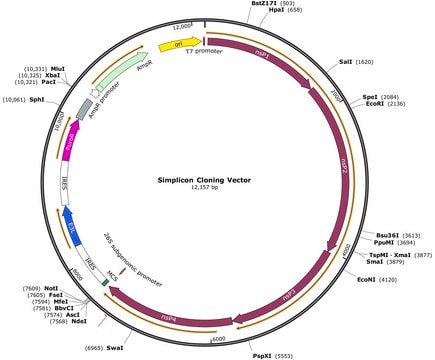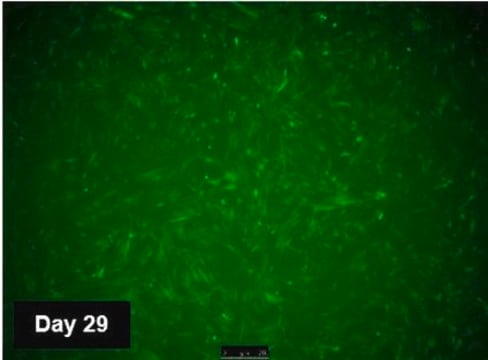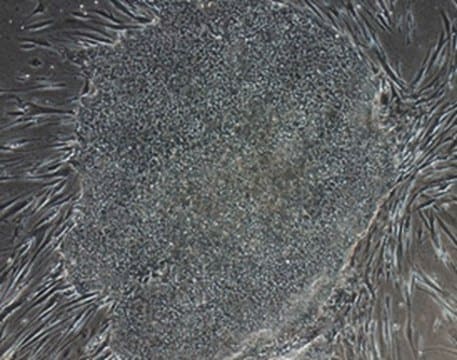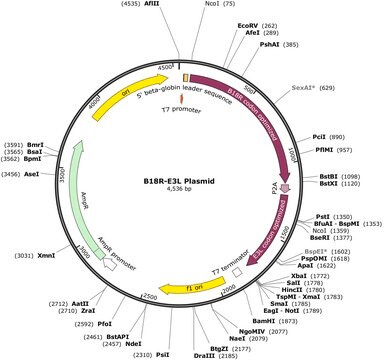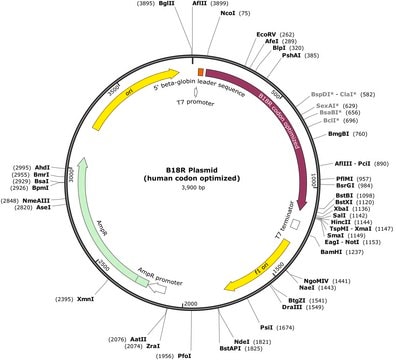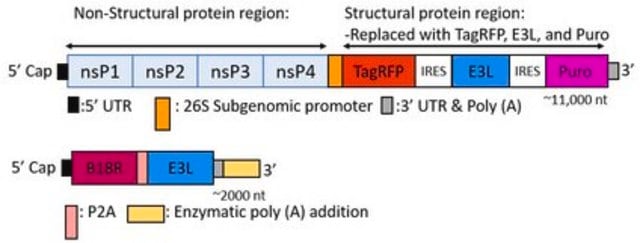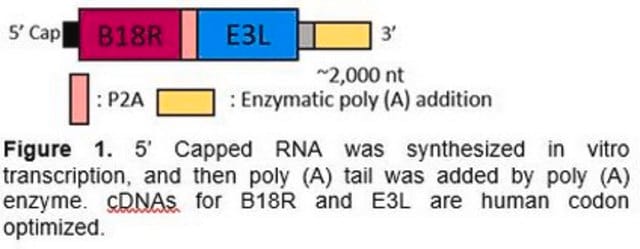SCR729
Human OKSG-cMyc TagRFP Simplicon® Plasmid
suitable for detection
Iniciar sesiónpara Ver la Fijación de precios por contrato y de la organización
About This Item
UNSPSC Code:
12352207
eCl@ss:
32161000
NACRES:
NA.51
Productos recomendados
application(s)
detection
shipped in
ambient
General description
Human OKSG-cMyc TagRFP Simplicon Plasmid is a DNA plasmid used to synthesize the self-replicating OKSG-cMyc TagRFP Simplicon RNA (Cat. No. SCR714) that is frequently used for reprogramming human somatic cells1,2.
The Simplicon technology utilizes a single self-replicating Venezuelan equine encephalitis (VEE) RNA species that express the reprogramming factors (RF) ORFs (OKSG-cMyc; Oct4, Klf4, Sox2, Glis1 and cMyc)1,2 along with a red fluorescent protein (TagRFP)3,4. The Simplicon RNA replicon is a synthetic polycistronic VEE RNA that is capable of self-replicating for a limited number of cell divisions. The OKSG-cMyc transgenes are especially useful for iPSCs generation from somatic cells that are more difficult to reprogram (i.e. slower proliferating cells or aged somatic cells)2 while the TagRFP provides a rapid assessment of transfection efficiency. The presence of the TagRFP transgene also allows for optimization of the transfection conditions in hard to transfect somatic or primary cells. TagRFP is a monomeric red (orange) fluorescent protein generated from the RFP of sea anemone Entacmaea quadricolor. TagRFP exhibits fluorescence with excitation/emission maxima at 555/584 nm respectively, and brightness that is nearly three times higher than mCherry3, 4.
Introduction and replication of the Simplicon RNA is expected to elicit a strong interferon response in transfected cells. To suppress the IFN responses, a Vaccinia virus protein5, B18R, is used for the original SimpliconTM technology. Recently, we found that another Vaccinia virus protein5, E3L, also suppresses the IFN responses in SimpliconTM RNA expression. B18R neutralizes type I interferons by direct binding, while E3L inhibits the cytoplasmic signaling pathways of IFN responses. Therefore, B18R and E3L are both employed in the SimpliconTM Expression System and work collaboratively to suppress IFN responses. As a result, there is increased cell viability during RNA transfection and increased expression of the transgenes. The Simplicon Expression System works in human cells and is not expected to work in mouse cells. This is because the B18R does not effectively neutralize mouse interferon (IFN)-β.
One day after transfection of OKSG-cMyc TagRFP Simplicon RNA, a spike in the level of TagRFP can be observed. The expression levels are maintained by addition of B18R and the selective agent, puromycin throughout the duration of the experiment. Expression levels and duration may change depending upon the cell types and media condition used.
Please note that the Human OKSG-cMyc TagRFP Simplicon Plasmid does not contain E3L, so E3L is not produced by OKSG-cMyc TagRFP Simplicon RNA. B18R-E3L RNA (Cat. No. SCR722) can be used to increase the viability and expression of the RFs by co-transfection with OKSG-cMyc TagRFP Simplicon RNA.
The Simplicon technology utilizes a single self-replicating Venezuelan equine encephalitis (VEE) RNA species that express the reprogramming factors (RF) ORFs (OKSG-cMyc; Oct4, Klf4, Sox2, Glis1 and cMyc)1,2 along with a red fluorescent protein (TagRFP)3,4. The Simplicon RNA replicon is a synthetic polycistronic VEE RNA that is capable of self-replicating for a limited number of cell divisions. The OKSG-cMyc transgenes are especially useful for iPSCs generation from somatic cells that are more difficult to reprogram (i.e. slower proliferating cells or aged somatic cells)2 while the TagRFP provides a rapid assessment of transfection efficiency. The presence of the TagRFP transgene also allows for optimization of the transfection conditions in hard to transfect somatic or primary cells. TagRFP is a monomeric red (orange) fluorescent protein generated from the RFP of sea anemone Entacmaea quadricolor. TagRFP exhibits fluorescence with excitation/emission maxima at 555/584 nm respectively, and brightness that is nearly three times higher than mCherry3, 4.
Introduction and replication of the Simplicon RNA is expected to elicit a strong interferon response in transfected cells. To suppress the IFN responses, a Vaccinia virus protein5, B18R, is used for the original SimpliconTM technology. Recently, we found that another Vaccinia virus protein5, E3L, also suppresses the IFN responses in SimpliconTM RNA expression. B18R neutralizes type I interferons by direct binding, while E3L inhibits the cytoplasmic signaling pathways of IFN responses. Therefore, B18R and E3L are both employed in the SimpliconTM Expression System and work collaboratively to suppress IFN responses. As a result, there is increased cell viability during RNA transfection and increased expression of the transgenes. The Simplicon Expression System works in human cells and is not expected to work in mouse cells. This is because the B18R does not effectively neutralize mouse interferon (IFN)-β.
One day after transfection of OKSG-cMyc TagRFP Simplicon RNA, a spike in the level of TagRFP can be observed. The expression levels are maintained by addition of B18R and the selective agent, puromycin throughout the duration of the experiment. Expression levels and duration may change depending upon the cell types and media condition used.
Please note that the Human OKSG-cMyc TagRFP Simplicon Plasmid does not contain E3L, so E3L is not produced by OKSG-cMyc TagRFP Simplicon RNA. B18R-E3L RNA (Cat. No. SCR722) can be used to increase the viability and expression of the RFs by co-transfection with OKSG-cMyc TagRFP Simplicon RNA.
Application
Advantages of the Simplicon OKSG-cMyc TagRFP RNA generated from Human OKSG-cMyc TagRFP Simplicon Plasmid:
• Integration-free, footprint-free iPSCs generation. No risk of genomic integration.
• Safe, virus-free, synthetic polycistronic RNA replicon (all five reprogramming factors in a single RNA strand)
• TagRFP reporter gene construct embedded in the RNA replicon that allows visualization and quantification of the transfection efficiency of the Simplicon RNA.
• Only one single transfection required. The RNA replicon is able to self-replicate, eliminating the need for additional daily transfections of multiple individual mRNAs over a 14-day period.
• Efficient and rapid reprogramming.
• No screening required to ensure the absence of viral remnants.
• Controlled elimination of synthetic VEE RNA replicon by the removal of B18R protein.
• Validated for reprogramming in feeder-free and feeder-based culture conditions.
• The OKSG-cMyc transgenes are especially useful for iPSCs generation from somatic cells that are more difficult to reprogram (i.e. slower proliferating cells or aged somatic cells) while the TagRFP provides a rapid assessment of transfection efficiency. Presence of the TagRFP transgene also allows for optimization of the transfection conditions in hard- to- transfect somatic or primary cells.
• Integration-free, footprint-free iPSCs generation. No risk of genomic integration.
• Safe, virus-free, synthetic polycistronic RNA replicon (all five reprogramming factors in a single RNA strand)
• TagRFP reporter gene construct embedded in the RNA replicon that allows visualization and quantification of the transfection efficiency of the Simplicon RNA.
• Only one single transfection required. The RNA replicon is able to self-replicate, eliminating the need for additional daily transfections of multiple individual mRNAs over a 14-day period.
• Efficient and rapid reprogramming.
• No screening required to ensure the absence of viral remnants.
• Controlled elimination of synthetic VEE RNA replicon by the removal of B18R protein.
• Validated for reprogramming in feeder-free and feeder-based culture conditions.
• The OKSG-cMyc transgenes are especially useful for iPSCs generation from somatic cells that are more difficult to reprogram (i.e. slower proliferating cells or aged somatic cells) while the TagRFP provides a rapid assessment of transfection efficiency. Presence of the TagRFP transgene also allows for optimization of the transfection conditions in hard- to- transfect somatic or primary cells.
Storage and Stability
Human OKSG-cMyc TagRFP Simplicon Plasmid (Cat. # CSR729). One (1) vial containing 10 µL of Plasmid (1 µg/µL). Store at -20 °C
Other Notes
Concentration: Please refer to lot specific datasheet.
Legal Information
SIMPLICON is a registered trademark of Merck KGaA, Darmstadt, Germany
Disclaimer
Unless otherwise stated in our catalog or other company documentation accompanying the product(s), our products are intended for research use only and are not to be used for any other purpose, which includes but is not limited to, unauthorized commercial uses, in vitro diagnostic uses, ex vivo or in vivo therapeutic uses or any type of consumption or application to humans or animals.
Storage Class
12 - Non Combustible Liquids
Certificados de análisis (COA)
Busque Certificados de análisis (COA) introduciendo el número de lote del producto. Los números de lote se encuentran en la etiqueta del producto después de las palabras «Lot» o «Batch»
¿Ya tiene este producto?
Encuentre la documentación para los productos que ha comprado recientemente en la Biblioteca de documentos.
Nuestro equipo de científicos tiene experiencia en todas las áreas de investigación: Ciencias de la vida, Ciencia de los materiales, Síntesis química, Cromatografía, Analítica y muchas otras.
Póngase en contacto con el Servicio técnico
